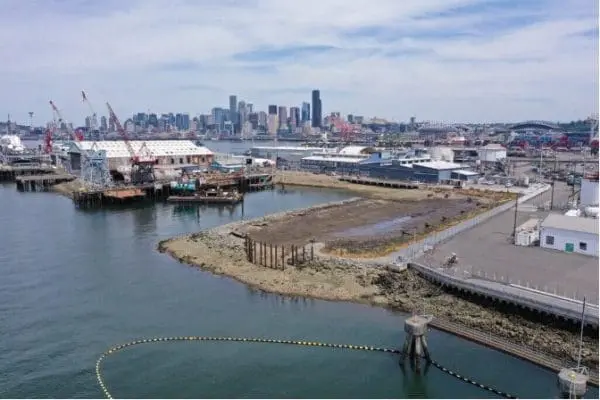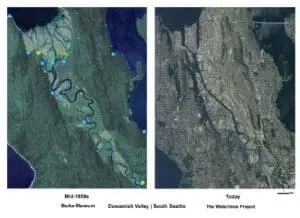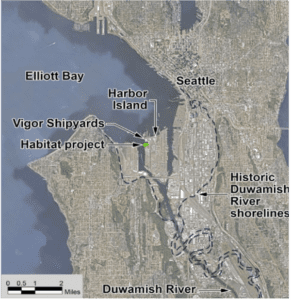
The Duwamish River System: Then and Now

The Duwamish Estuary in 1922. Image credit: Burke Museum blog (File Photo/The Seattle Times)
The Duwamish River system and the land around it has been a central part of what is now South Seattle’s ecosystem for thousands of years. It was once a wide, meandering river with landscapes of mudflats and marshes. The system contained critical estuary habitat for juvenile salmon, shorebirds, and spawning herring. The land was stewarded since time immemorial by Indigenous communities and used for fishing, shellfish harvesting, and transportation.
In the mid-1800s, settlers came to the area and quickly altered the landscape for their own needs by channelizing the lower section of the Duwamish River and by filling in the estuary. By the 1940s, the abundant nine-mile estuary was transformed into a seven-mile industrial waterway now home to modern Seattle. Through this process, the river lost 97% of the critical habitat it once provided juvenile salmon.

The Duwamish Estuary, then and now. Image Credit: Burke Museum blog (Waterlines Project)
Part of the large-scale efforts to change the Duwamish included the creation of Harbor Island, a 420-acre artificial island where tidal mudflats at the mouth of the river once fed the marine ecosystem. This artificial island has supported industrial facilities since its creation in 1909, including shipbuilding and repair, cargo handling, bulk petroleum storage and transfers, and metal smelting, recycling and fabrication. The waterway now serves as a major shipping route for bulk cargo, and the island and its surrounding facilities are considered a major hub in the Pacific Northwest maritime industry.
Over the decades after Harbor Island was created, extremely hazardous substances were released into the sediment and water. In 1983, Harbor Island was declared a Superfund Site by the EPA, making it one of the initial sites listed on the United States’ National Priorities List for cleanup. “Superfund” is the informal name of a federal law that requires the nation’s most toxic sites to be identified and cleaned up. In 2001, the Lower Duwamish Waterway was declared a Superfund Site by the EPA, identifying it as one of the country’s most toxic hazardous waste sites.
Contaminant cleanup of the Lower Duwamish River is in progress and will be for many years. This work alone will not restore the natural resources that have been impacted by the alteration of this system.
Juvenile salmon need to spend time in estuaries to feed, rest, and grow as they transition from freshwater to saltwater during their outmigration to the ocean. Currently there are not enough places for fish to rest and spend time in the Lower Duwamish River throughout their life cycle. To restore these resources, additional habitat must be created.
Shipyards have operated on Harbor Island since the early 1900s. A total of 32 acres of marine sediments were contaminated from historical shipyard operations and were identified as a cleanup location. In 2005, sources of contamination were contained, and 200,000 cubic yards of contaminated sediment were removed. When Vigor Industrial acquired the shipyard in 2011, they assumed the remaining liability for the historical releases of contamination from the property into Elliott Bay and the Duwamish River.
Under the Superfund enforcement there are different options to settle the damage for natural resources, including monetary payment to agencies conducting the cleanup, off-site habitat restoration, or on-site habitat restoration. After considering where to focus their efforts, Vigor decided to create a pocket estuary on their property, demolishing shipyard infrastructure and constructing over three acres of new aquatic habitat, including salt marsh and tideflat areas to reflect what the estuary once looked like.

Vigor Shipyards is the site of an ongoing habitat restoration site.
The hope is that this restoration effort will support juvenile salmon health at a key location at the mouth of the Duwamish River Estuary. Habitat construction at the shipyard was completed in 2023, and Vigor will permanently maintain the habitat features. Scientists at the University of Washington’s Wetland Ecosystem Team and Long Live the Kings took samples at the site before restoration and continue to monitor the habitat function after restoration to understand any changes in fish use, insects, and vegetation that may occur at the site.